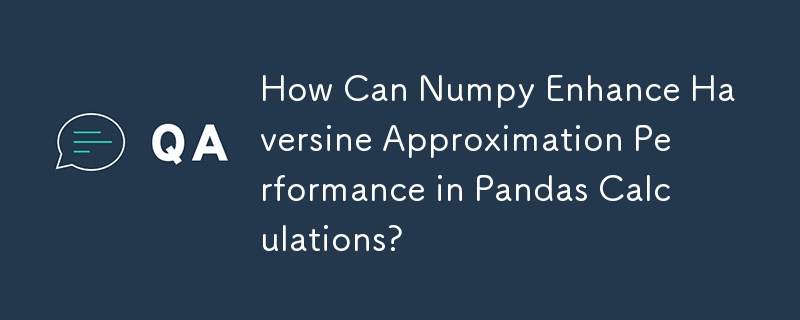

Fast Haversine Approximation: Leveraging Numpy for Enhanced Performance in Pandas Calculations
Calculating distances between pairs of coordinates in a Pandas DataFrame using the haversine formula can be computationally expensive for large datasets. However, when the points are relatively close and accuracy requirements are relaxed, a faster approximation is possible.
Consider the following code snippet:
<code class="python">def haversine(lon1, lat1, lon2, lat2):
... # (haversine calculation)
for index, row in df.iterrows():
df.loc[index, 'distance'] = haversine(row['a_longitude'], row['a_latitude'], row['b_longitude'], row['b_latitude'])</code>To optimize the performance of this code, we can leverage Numpy's powerful array operations and vectorization capabilities. This approach eliminates the need for looping and enables efficient processing of entire arrays simultaneously.
Here's a vectorized implementation using Numpy:
<code class="python">import numpy as np
def haversine_np(lon1, lat1, lon2, lat2):
... # (haversine calculation)
inputs = map(np.radians, [lon1, lat1, lon2, lat2])
distance = haversine_np(*inputs)</code>To incorporate this into a Pandas DataFrame, we can simply use the following:
<code class="python">df['distance'] = haversine_np(df['lon1'], df['lat1'], df['lon2'], df['lat2'])</code>
This vectorized approach takes advantage of Numpy's optimized operations and eliminates the time-consuming looping process. Consequently, the calculation is significantly faster, especially for large datasets. By leveraging the power of Numpy, we can achieve faster and more efficient haversine approximations in Pandas.
The above is the detailed content of How Can Numpy Enhance Haversine Approximation Performance in Pandas Calculations?. For more information, please follow other related articles on the PHP Chinese website!
 The difference between gateway and router
The difference between gateway and router
 How to recover files emptied from Recycle Bin
How to recover files emptied from Recycle Bin
 How to fix libcurl.dll missing from your computer
How to fix libcurl.dll missing from your computer
 Delete exif information
Delete exif information
 WiFi shows no access to the Internet
WiFi shows no access to the Internet
 My computer can't open it by double-clicking it.
My computer can't open it by double-clicking it.
 How to restore friends after being blocked on TikTok
How to restore friends after being blocked on TikTok
 Introduction to javascript special effects code
Introduction to javascript special effects code




